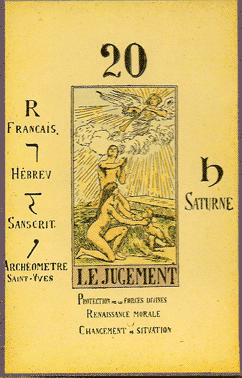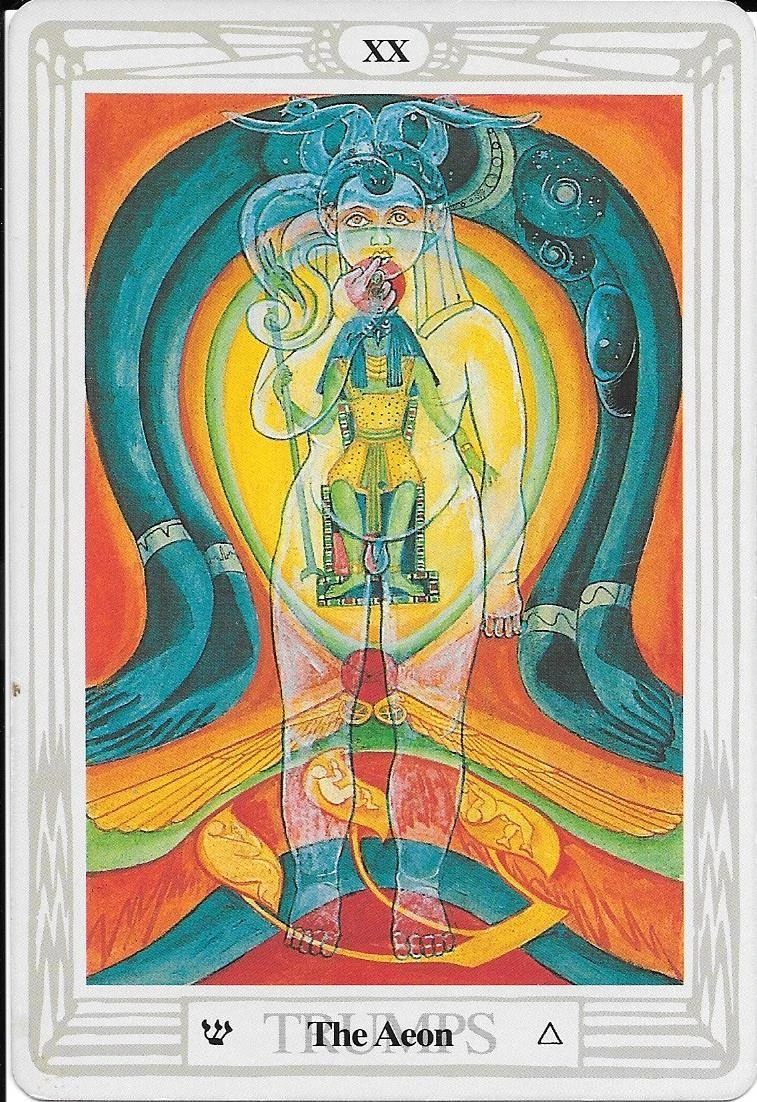Tarot Deep Dive - Judgement
- Dustin

- Aug 20, 2023
- 6 min read
Updated: Aug 21, 2023
Every card represents an aspect of humanity that has echoed through time. In this series we are going to dive into the history of the imagery found within the tarot, the meaning of the cards and how that meaning changed over time, and the symbols present within the images of what is arguably the most well-known tarot deck of all time - the Rider-Waite (Smith) Tarot Deck. So, grab your favorite RWS deck, a cup of tea or coffee, and join me live on Sunday mornings over on YouTube as we Deep Dive into each one of the 21 Major Arcana cards continuing now with the end of times - Judgement! A note to the reader - The scene of the Last Judgement is a topic of such great breadth and depth that entire books have been written on the subject and would be nearly impossible to summarize in this blog. Instead we will look briefly at the art historical depiction and symbolic nature of The Last Judgement as it pertains specifically to The Judgement arcana within the Tarot.
The Last Judgement
The Last Judgement is probably one of the most produced compositional scenes in art history. Painted by nearly every great master you can find this Christian iconography on nearly any surface within Medieval and Renaissance religious architecture, and it even adorned some public spaces too. Probably the most famous depiction of this scene was done by Michelangelo which adorns the entirety of the wall behind the altar within the Sistine Chapel within the Vatican which was inspired by Dante's Divine Comedy and was considered highly controversial at the time because of the nude figures that were later covered by a student of Michelangelo and then uncovered in modern times during restoration work. It also drew controversy with its inclusion of classical pagan mythological figures such as Charon seen ushering souls across the river into Hell.

The scene traditionally depicts the second coming of Christ during the Rapture as described in the Bible within the Book of Revelations. This scene was widely used in a propagandist manner by the early church to quite literally scare people, and this earned these depictions of The Last Judgement the title "Doom Paintings", first referenced in the 13th century. One good example of this style can be found on the Burgundian cathedral of Saint Lazarus at Autun which has a large sculptural façade of The Last Judgement added in 1132 for its tympanum which people would be confronted with every time they entered the cathedral. In a largely illiterate world, this scene depicted the end of days in vivid detail. In the words of Bernard of Clairvaux, "read in the marble." For the literate the Autun clergy also composed an explicit message to reinforce the pictorial message and and the words "May this terror terrify those whom earthly error binds, for the horror of these images here in the manner truly depicts what will be." For the keen eyed you may also noticed the signs of the zodiac surrounding the scene - which was not uncommon for early Judeo-Christian art and is a interesting part of art history to explore.

Visual evolution
Just as we see in the rest of the major arcana, Judgement clearly draws its imagery from the allegorical depictions of The Last Judgement we see scattered across Europe. Our earliest depictions of this card draw distinctly from the Renaissance mater's depiction of this scene as we can see from the Visconti deck. Interestingly though, this card turns the focus away from the "doom and gloom" typically depicted in this art historical troupe and instead focuses on the more positive side of the composition of the dead being awakened and raising from their graves by a heralding angel with the figures depicted in a gracious manner looking up at rather jovial depiction of God. Though many occultists will attribute this as a choice to represent the concepts of life, death, and rebirth within the major arcana - it is critical we remember that these cards were originally created as a domestic table game for family leisure - so draw your own conclusions as to why the artist focused the composition in this way. We see the angel take center stage over God later in in the early French and Swiss decks, such as the Parisian Tarot from c1600. This is likely due to the spread of Protestantism and their strong views against graven images of God that we saw influence all Christian art of the time. This composition stays almost completely unchanged throughout the rest of the history of Tarot art with almost no major compositional changes until the modern era where we see Crowley diverge fully from the tradition and redesign the card as Aeon which still carries many of the symbolic overtones as Judgement, as we will explore below, but visually is completely different.
Evolution of Meaning
De Mellet (1781): The Angel. The creation of man. Men and women formed from the earth, summoned by Osiris.
Mathers (1888): The Last Judgement. Renewal, result, determination of matter.
Golden Dawn (1896): The Spirit of the Primal Fire. Judgement. Final decision. Sentence.
Waite (1910): The Last Judgement. Change of position, renewal, outcome. Another account specifies total loss through a lawsuit.
Crowley (1944): In this card it has been necessary to depart completely from the tradition of the cards, in order to carry on that tradition. The old card was called The Angel: or, The Last Judgment. It represented an Angel or Messenger blowing a trumpet, attached to which was a flag, bearing the symbol of the Aeon of Osiris. Below him the graves were opening, the dead rising up. There were three of them. The central one had his hands raised with right angles at the elbows and shoulders, so as to form the letter Shin, which refers to Fire. The card therefore represented the destruction of the world by Fire. This was accomplished in the year of the vulgar era 1904, when the fiery god Horus took the place of the airy god Osiris in the East as Hierophant (see Atu V). At the beginning, then, of this new Aeon, it is fit to exhibit the message of that angel who brought the news of the new Aeon to earth. The new card is thus of necessity an adaptation of the Stélé of Revealing.
The Symbols
The Angel

The angel depicted in the card is often thought to be Raphael, the angel of air - the same angel depicted on The Lovers. Others think it could be Metatron or Israfil the angel who blows the trumpet to signal Qiyamah (the Day of Judgment) in Islam.
The Flag

The flag on the horn of the angel is that of St. George which references the 15th chapter of 1st Corinthians.
Graves & Figures

Three grey skinned dead bodies raise from their grave to be taken into heaven. They stand in traditional early Jeudeo-Christian ossuaries. Reversed the figures are thought to represent the word lux, Latin for 'light' - though its unclear if this was intentional or not.
Possibly thought to represent the three ages of man or a nuclear family of man, woman, and child.
The Snowy Mountains

As we discussed in Symbols of the Tarot - Earth; mountains represent obstacles you must overcome in general and these being covered in snow represent the end of a cycle.
As always be sure to check out our live discussion on this very topic over on YouTube:
References
Barbier, L. (2021). Tarot and divination cards: A visual archive. Cernunnos, 2021.
Butler, B. Dictionary of the Tarot. New York: Schocken Books, 1986.
Chang, T. Susan. Tarot Correspondences: Ancient Secrets for Everyday Readers. Llewellyn Pulbications, 2018.
Crowley, Aleister (aleister Crowley). Book of Thoth - (Egyptian Tarot). Red Wheel/Weiser, 2017.
Dean, Liz. The Ultimate Guide to Tarot: a Beginners Guide to the Cards, Spreads, and Revealing the Mystery of the Tarot. Fair Winds Press, 2015.
Decker, Ronald; Dummett, Michael. A History of the Occult Tarot. London: Duckworth, 2019.
Farley, Helen. A Cultural History of Tarot: From Entertainment to Esotericism. Bloomsbury Academic, 2019.
Fiebig, Johannes, and Evelin Burger. The Ultimate Guide to the Rider Waite Tarot. Llewellyn, 2013.
Gardner, H., Kleiner, F. S., & Mamiya, C. J. (2005). Gardner’s Art through ages 12th edition (2005). Thomson/Wadsworth.
Katz, Marcus. Secrets of the Waite-Smith Tarot: the True Story of the Worlds Most Popular Tarot: with Previously Unseen Photography & Text from Waite & Smith. Llewellyn Publications, 2015.
Place, R. M. The fool's journey: The history, art, & symbolism of the tarot. York, 2010.
Waite, A. E. Pictorial Key to the Tarot. Dover Publications Inc, 2005.
Wen, Benebell. Holistic Tarot. North Atlantic Books, 2015.












Comments